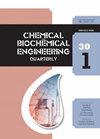Bioethanol Production from Dilute-acid Pre-treated Wheat Straw Liquor Hydrolysate by Genetically Engineered Saccharomyces cerevisiae
IF 0.9
4区 生物学
Q4 BIOTECHNOLOGY & APPLIED MICROBIOLOGY
引用次数: 12
Abstract
Sustainable recycling of lignocellulosic biomass includes utilization of all carbohydrates present in its hydrolysates. Since wheat straw is a xylose-rich raw material, utilization of xylose from obtained liquid part (liquor) of hydrolysates improves overall bioprocess efficiency. In this work, dilute acid pre-treatment of wheat straw was performed in high-pressure reactor at different temperatures (160 °C – 200 °C), residence times (1 min – 10 min), and acids (H2SO4 and H3PO4) concentrations. During dilute acid pre- treatment, hemicellulose is degraded to pentose sugars that cannot be used by industrial ethanol- producing yeasts. Therefore, genetically engineered Saccharomyces cerevisiae strain that can utilize xylose was used. Fermentations were performed on different xylose-rich liquor wheat straw hydrolysates in shake-flasks and in horizontal rotating tubular bioreactor. The efficiency of fermentations carried out in shake flasks using xylose- rich liquor wheat straw hydrolysates were in the range of 19.61 – 74.51 %. However, the maximum bioprocess efficiency (88.24 %) was observed during fermentation in the HRTB on the liquor wheat straw hydrolysate obtained by pre- treatment with 2 % w/w phosphoric acid.利用转基因酿酒酵母水解稀酸预处理麦草液生产生物乙醇
木质纤维素生物质的可持续回收包括利用其水解产物中存在的所有碳水化合物。由于麦秆是富含木糖的原料,从水解产物的液体部分(液体)中利用木糖提高了整个生物过程的效率。在这项工作中,在高压反应器中,在不同温度(160°C–200°C)、停留时间(1分钟–10分钟)和酸(H2SO4和H3PO4)浓度下对麦草进行稀酸预处理。在稀酸预处理过程中,半纤维素被降解为工业乙醇生产酵母所不能使用的戊糖。因此,使用了能够利用木糖的基因工程酿酒酵母菌株。在摇瓶和水平旋转管式生物反应器中对不同的富含木糖的麦秆水解液进行发酵。在摇瓶中使用富含木糖的小麦秸秆水解液进行发酵的效率在19.61–74.51%之间。然而,在用2%w/w磷酸预处理得到的麦草水解液的HRTB发酵过程中,观察到最大的生物工艺效率(88.24%)。
本文章由计算机程序翻译,如有差异,请以英文原文为准。
求助全文
约1分钟内获得全文
求助全文
来源期刊
CiteScore
2.70
自引率
6.70%
发文量
23
审稿时长
>12 weeks
期刊介绍:
The journal provides an international forum for presentation of original papers, reviews and discussions on the latest developments in chemical and biochemical engineering. The scope of the journal is wide and no limitation except relevance to chemical and biochemical engineering is required.
The criteria for the acceptance of papers are originality, quality of work and clarity of style. All papers are subject to reviewing by at least two international experts (blind peer review).
The language of the journal is English. Final versions of the manuscripts are subject to metric (SI units and IUPAC recommendations) and English language reviewing.
Editor and Editorial board make the final decision about acceptance of a manuscript.
Page charges are excluded.

 求助内容:
求助内容: 应助结果提醒方式:
应助结果提醒方式:


